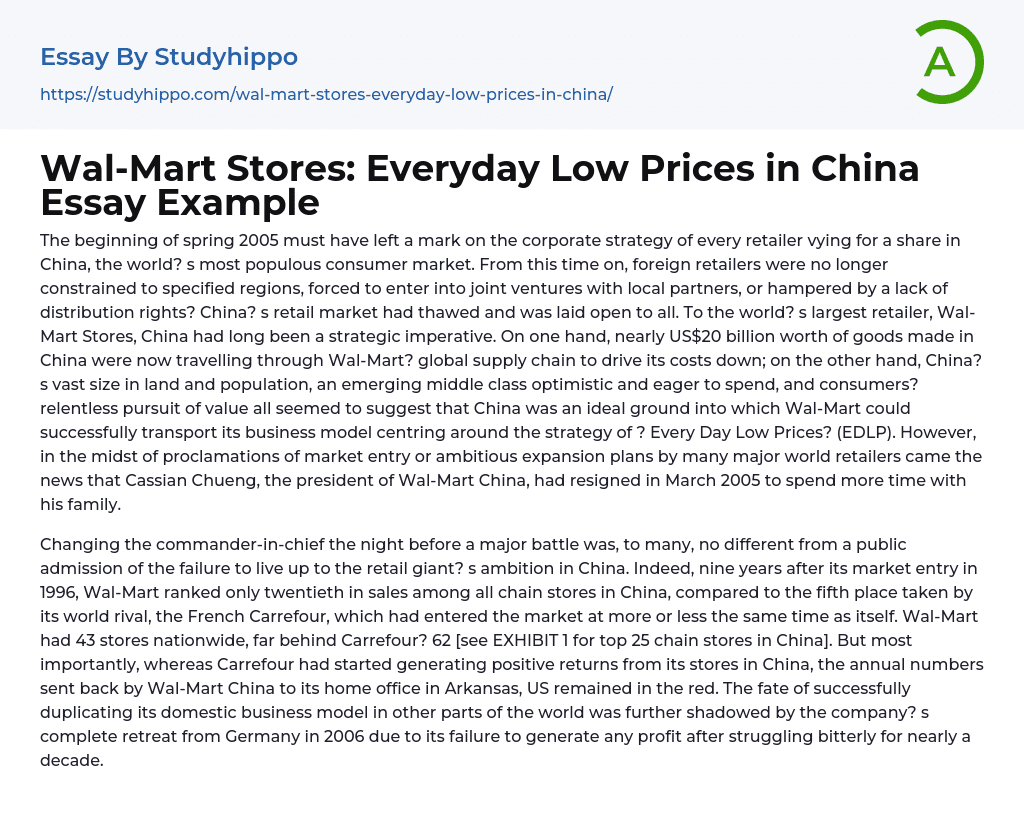

Wal-Mart Stores: Everyday Low Prices in China Essay Example
The beginning of spring 2005 must have left a mark on the corporate strategy of every retailer vying for a share in China, the world? s most populous consumer market. From this time on, foreign retailers were no longer constrained to specified regions, forced to enter into joint ventures with local partners, or hampered by a lack of distribution rights? China? s retail market had thawed and was laid open to all. To the world? s largest retailer, Wal-Mart Stores, China had long been a strategic imperative. On one hand, nearly US$20 billion worth of goods made in China were now travelling through Wal-Mart? global supply chain to drive its costs down; on the other hand, China? s vast size in land and population, an emerging middle class optimistic and eager to spend, and consumers? relentless pursuit of valu
...e all seemed to suggest that China was an ideal ground into which Wal-Mart could successfully transport its business model centring around the strategy of ? Every Day Low Prices? (EDLP). However, in the midst of proclamations of market entry or ambitious expansion plans by many major world retailers came the news that Cassian Chueng, the president of Wal-Mart China, had resigned in March 2005 to spend more time with his family.
Changing the commander-in-chief the night before a major battle was, to many, no different from a public admission of the failure to live up to the retail giant? s ambition in China. Indeed, nine years after its market entry in 1996, Wal-Mart ranked only twentieth in sales among all chain stores in China, compared to the fifth place taken by its world rival, the French Carrefour
which had entered the market at more or less the same time as itself. Wal-Mart had 43 stores nationwide, far behind Carrefour? 62 [see EXHIBIT 1 for top 25 chain stores in China]. But most importantly, whereas Carrefour had started generating positive returns from its stores in China, the annual numbers sent back by Wal-Mart China to its home office in Arkansas, US remained in the red. The fate of successfully duplicating its domestic business model in other parts of the world was further shadowed by the company? s complete retreat from Germany in 2006 due to its failure to generate any profit after struggling bitterly for nearly a decade.
- Chief Executive Officer essays
- Convenience Store essays
- Firm essays
- Training And Development essays
- Unilever essays
- Variable Cost essays
- Virgin Group essays
- Bargaining essays
- Entity essays
- Pest analysis essays
- Advertising essays
- Audience Theory essays
- Competitor Analysis essays
- Consumer essays
- Marketing Management essays
- Marketing Mix essays
- Marketing Plan essays
- Marketing Research essays
- Marketing Strategy essays
- Point Of Sale essays
- Price essays
- Procurement essays
- Product essays
- Product Differentiation essays
- Promotion essays
- Promotion And Marketing Communications essays
- Retailing essays
- Trademark essays
- Anheuser-busch essays
- Brands essays
- Detergent essays
- Product Placement essays
- Research Design essays
- New Product Development essays
- Advertisement essays
- Brand essays
- Sales Promotion essays
- Advertising campaign essays
- Consumer behaviour essays
- Offer And Acceptance essays
- Wal-Mart essays
- Discover essays
- John Locke essays
- 9/11 essays
- A Good Teacher essays
- A Healthy Diet essays
- A Modest Proposal essays
- A&P essays
- Academic Achievement essays
- Achievement essays



